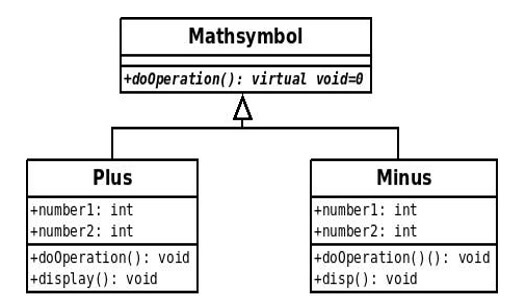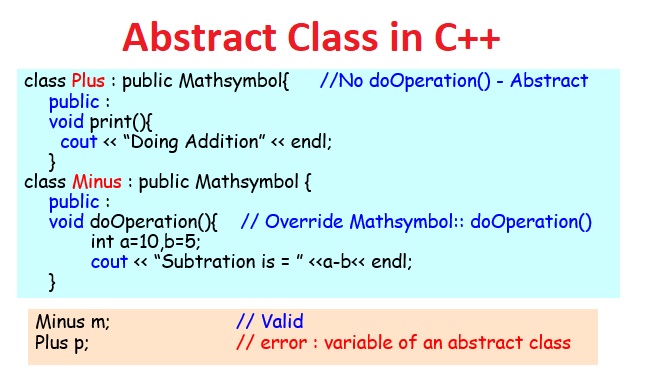A class with one or more pure virtual functions is an Abstract Class in C++, Objects of abstract class can’t be created
- Abstract Class is a class which contains atl east one Pure Virtual function in it.
- Abstract classes are used to provide an Interface for its sub classes.
- Classes inheriting an Abstract Class must provide definition to the pure virtual function, otherwise they will also become abstract class.
- But pointer of abstract class can hold address of derived class
Simple Example Math Symbol Problem
Create an abstract class MathSymbol may provide a pure virtual function doOperation(), and create two more classes Plus and Minus implement doOperation() to provide concrete implementations of addition in Plus class and subtraction in Minus class.
Algorithm for Math Symbol Problem
- Create Mathsymbol abstract class in c++ with doOperation() pure virtual function.
- Create plus class derived from Mathsymbol.
- Create minus class dervied from Mathsymbol.
- Perform addition in plus class using doOperation() pure virtual function.
- Perform subtraction in minus class using doOperation() pure virtual function.
- Print each values in respective classes.
Implementation Abstract Class in C++
- Already learnt creating classes
- Learnt about Inheritance
- Define Pure virtual function in Abstract(base) class.
- Inherit virtual function for distinct operations.
- Already learnt about how to display the output.
Class Diagram using Dia

Simple Example
- Some classes exist logically but not physically.
- Example : Mathsymbol
–Mathsymbol M;
–Mathssymbol makes sense only as a base of some classes derived from it. Serves as a “category”
–Hence instantiation of such a class must be prevented
class Mathsymbol //Abstract
{
public :
//Pure virtual Function
virtual void doOperation() = 0;
}
Mathsymbol M; // error : variable of an abstract class
- A pure virtual function not defined in the derived class remains a pure virtual function.
- Hence derived class also becomes abstract
class Plus : public Mathsymbol{ //No doOperation() – Abstract
public :
void print(){
cout << “Doing Addition” << endl;
}
class Minus : public Mathsymbol {
public :
void doOperation(){ // Override Mathsymbol:: doOperation()
int a=10,b=5;
cout << “Subtration is = ” <<a-b<< endl;
}
Minus m; // Valid
Plus p; // error : variable of an abstract class
- It is still possible to provide definition of a pure virtual function in the base class
- The class still remains abstract and functions must be redefined in the derived classes, but a common piece of code can be kept there to facilitate reuse
- In this case, they can not be declared inline
| class Mathsymbol { //Abstract public : virtual void doOperation() = 0;};// OK, not defined inlinevoid Mathsymbol::doOperation(){ cout << “Arithmetic” << endl; } |
class Minus : public Mathsymbol
{ |
Example: Pure Virtual Functions
| class A {
public: virtual void x() = 0; virtual void y() = 0; }; |
|
| class B : public A {
public: virtual void x(); }; |
|
| class C : public B {
public: virtual void y(); }; |
|
| int main () {
A * ap = new C; ap->x (); ap->y (); delete ap; return 0; }; |
|
Pure Virtual Functions: Summary
- Pure virtual functions are useful because they make explicit the abstractness of a class
- Tell both the user and the compiler how it was intended to be used
- Note : It is a good idea to keep the common code as close as possible to the root of you hierarchy
Difference b/w Virtual and Pure Virtual Function
A pure virtual function makes the class it is defined for abstract. Abstract classes cannot be instantiated. Derived classes need to override/implement all inherited pure virtual functions. If they do not, they too will become abstract. In C++, a class can define a pure virtual function that has an implementation.
Pure Virtual Function
- A pure virtual function is a function that has the notation “= 0” in the declaration of that function. Why we would want a pure virtual function and what a pure virtual function looks like is explored in more detail below.
- Simple Example of a pure virtual function in C++
- class SomeClass
{ public: virtual void pure_virtual() = 0; // a pure virtual function // note that there is no function body
};
Runtime Polymorphism
- Definition
- Ability to take more than one form
- An essential feature of an OO Language
- It builds upon Inheritance
- Allows run-time interpretation of object type for a given class hierarchy
- Also Known as “Late Binding”
- Implemented in C++ using virtual functions
Dynamic Binding
- Is the run time determination of which function to call for a particular object of a derived class based on the type of the argument
- Declaring a member function to be virtual instructs the compiler to generate code that guarantees dynamic binding
- Dynamic binding requires pass-by-reference
| Read More Topics |
| Image Processing |
| C++ Inheritance |
| Dynamic Memory Allocation |
| Program Design in C Language |






